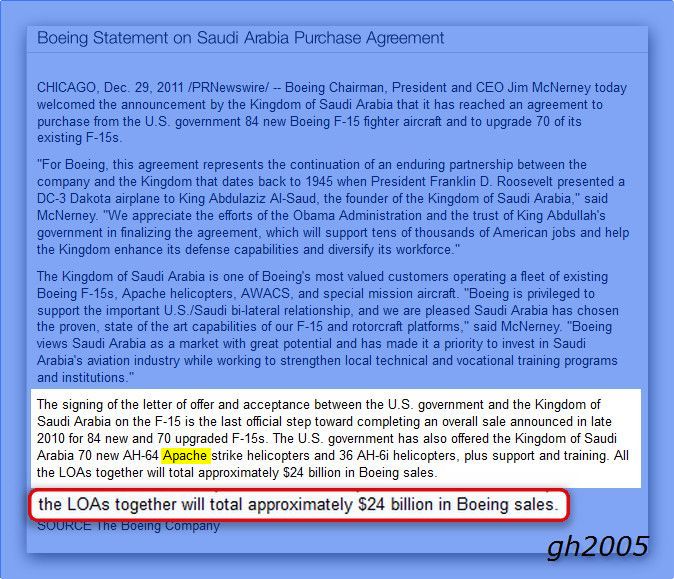رد: الاتفاق على صفقة f15 السعوديه ,,
Saudi Arabia to Order 180 New Helicopters for a New National Guard Aviation Regiment
October 21, 2010
The recently announced acquisition of more than 180 helicopters for the Saudi Arabian National Guards (SANG) provides the first major step in expansion of the SANG Aviation Command, established in 2006. The announced package worth well over $25 billion equals the modernization of the Royal Saudi Air Force’s F-15 force.
As part of this package the U.S. will supply 36 new AH-64D attack helicopters, upgrading of existing Apaches, delivery of 36 AH-6 Little Bird light attack helicopters. The package also includes 72 Sikorsky UH-60M Black Hawk assault helicopters and 12 MD530 scout/liaison light helicopters.
The SANG aviation regiment will field 36 AH-64D (Apache Block III) attack helicopters, of which up to 20 will be equipped with mast mounted targeting systems, comprising the AN/APG-78 Fire Control Radars and AN/APR-48A Radar Frequency Interferometer sets. The 36 AH-6i light attack helicopters will carry Wescam MX15Di EO targeting systems, and be armed with GAU-19A 12.7mm Gatling guns and launchers for the firing of AGM-114R HELLFIRE II Missiles.
In addition to the RSNG Apache acquisition the Royal Saudi Land Forces (RSLF) will also invest $3.3 billion acquiring 24 additional Block III Apaches, under a separate order. 10 of these helicopters will be fitted with the mast mounted target acquisition kit. For these gunships the Saudis opted for a weapons mix comprising of AGM-114R Hellfire, 30 mm automatic gun and 70mm laser guided rockets. The helicopters will be equipped with airborne satellite communications terminals. In addition, the Saudi Arabian Royal Guard will also buy 10 Apache Block IIIs, on a third order worth $2.2 billion. The configuration and weapon’s mix on these helicopters is almost identical to that of the Saudi Army.
© 2010 defense-update.com
October 21, 2010
The recently announced acquisition of more than 180 helicopters for the Saudi Arabian National Guards (SANG) provides the first major step in expansion of the SANG Aviation Command, established in 2006. The announced package worth well over $25 billion equals the modernization of the Royal Saudi Air Force’s F-15 force.
As part of this package the U.S. will supply 36 new AH-64D attack helicopters, upgrading of existing Apaches, delivery of 36 AH-6 Little Bird light attack helicopters. The package also includes 72 Sikorsky UH-60M Black Hawk assault helicopters and 12 MD530 scout/liaison light helicopters.
The SANG aviation regiment will field 36 AH-64D (Apache Block III) attack helicopters, of which up to 20 will be equipped with mast mounted targeting systems, comprising the AN/APG-78 Fire Control Radars and AN/APR-48A Radar Frequency Interferometer sets. The 36 AH-6i light attack helicopters will carry Wescam MX15Di EO targeting systems, and be armed with GAU-19A 12.7mm Gatling guns and launchers for the firing of AGM-114R HELLFIRE II Missiles.
In addition to the RSNG Apache acquisition the Royal Saudi Land Forces (RSLF) will also invest $3.3 billion acquiring 24 additional Block III Apaches, under a separate order. 10 of these helicopters will be fitted with the mast mounted target acquisition kit. For these gunships the Saudis opted for a weapons mix comprising of AGM-114R Hellfire, 30 mm automatic gun and 70mm laser guided rockets. The helicopters will be equipped with airborne satellite communications terminals. In addition, the Saudi Arabian Royal Guard will also buy 10 Apache Block IIIs, on a third order worth $2.2 billion. The configuration and weapon’s mix on these helicopters is almost identical to that of the Saudi Army.
© 2010 defense-update.com




